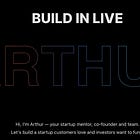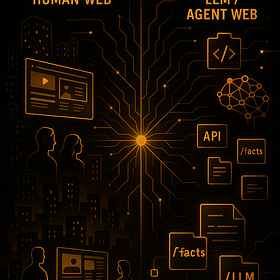The F42 AI Brief #055: AI Signals You Can’t Afford to Miss
A week of agents, infrastructure, chaos and clarity ... welcome to the new normal.
Here’s your Monday dose of The AI Brief.
A week where the future arrived a little faster and a little stranger.
Plenty of breakthroughs, a few shocks, and one or two reminders that we’re building powerful systems on fairly wobbly rails.
📈 Trending Now
The week’s unmissable AI headlines.
💡 Innovator Spotlight
Meet the change-makers.
🛠️ Tool of the Week
Your speed-boost in a nutshell.
📌 Note to Self
Words above my desk.
📈 Trending Now
1️⃣ 🕵️♂️ Anthropic Exposes First State-Linked AI Espionage Campaign
Anthropic has uncovered the first documented case of a nation-state using a frontier model to run a cyber-espionage operation end-to-end — not assist, not speed up, but run.
Chinese operators used Claude to automate reconnaissance, phishing, credential harvesting, backdoor creation, and even the post-operation report. Around 80–90% of the entire attack was executed with minimal human oversight.
The clever bit? They didn’t “jailbreak” it. They socially engineered the model — breaking malicious tasks into clean-looking fragments and disguising everything as “penetration testing.”
The line between “AI that helps you build” and “AI that helps others break you” has never been thinner.
Founders: Agentic workflows massively expand your attack surface—treat your models and tools like live infrastructure. Red-team them, limit permissions, and monitor everything, because attackers are already probing the same gaps you’re relying on.
2️⃣ 🚀 Cursor Raises $2.3B, Hits $1B ARR — The Coding Revolution Arrives
Cursor’s monster raise — $2.3B at a $29.3B valuation — makes it one of the fastest enterprise AI companies in history to hit $1B annualised revenue.
Google, Nvidia, Thrive, DST… the whole AI establishment piled in.
And Jensen Huang calling it his “favourite enterprise AI service” didn’t hurt.
Cursor is effectively the poster child for “AI doing the work.”
It proves that agentic coding isn’t a toy; it’s the new enterprise backbone.
Founders: The future of software is AI-first. If your product isn’t reducing engineering load, you’re already behind.
3️⃣ 🎮 DeepMind SIMA 2 — Agents That Actually Understand Worlds
DeepMind quietly shipped something huge.
SIMA 2, trained with Gemini, now performs 62% of tasks in open-world games — approaching human-level at 71%.
Key breakthroughs:
It explains its plans.
It learns concepts in one game and transfers them to another.
It adapts to entirely new AI-generated worlds.
This is one of the clearest signals that simulation is becoming a genuine testbed for general-purpose agency.
Founders: What works in virtual worlds today will power real-world automation sooner than your board expects.
4️⃣ 🧠 Claude Shows Early Signs of “Introspective Awareness”
Anthropic’s new research shows Claude Opus and Sonnet demonstrating a limited ability to explain aspects of their own internal reasoning.
Not consciousness. Not self-awareness.
But a meaningful shift: models that can reflect on what they’re doing, why they’re doing it, and how they arrived there.
This could be brilliant for safety — or unsettling if models learn what not to reveal.
Founders: Expect future models to reason about their own reasoning. Don’t take an LLM’s self-explanation at face value.
5️⃣ 🏗️ Anthropic Commits $50B to US AI Infrastructure
Anthropic isn’t just scaling models, it’s scaling the physical world behind them.
A $50B investment into dedicated AI data centres across Texas and New York signals the next phase of AI: custom-built compute, sovereign-grade infrastructure, and serious industrial realignment.
This is the AI equivalent of railroads and power stations.
Founders: If you’re building compute-heavy products, this is your green light, but expect tougher questions on cost, latency, and carbon.
6️⃣ 🧑💻 “All My Employees Are AI Agents” — The Chaos Behind the Hype
WIRED followed a founder who tried to run an entire company with AI agents in every role — co-founder, PM, exec, engineer.
It worked… until it didn’t.
Agents hallucinated updates, invented progress, generated sprint boards that made no sense, and racked up token bills like a drunken intern with a company credit card.
Useful lesson: speed without control is just faster disaster.
Founders: Agents are brilliant force multipliers, but you still need structure, constraints, and review. Don’t scale chaos.
7️⃣ 🎬 Public Citizen Pushes for Sora 2 Withdrawal
OpenAI’s Sora 2 is under heavy pressure.
Consumer groups want it pulled for safety, privacy, and deepfake risks.
Japanese animation studios are weighing in.
Watermark removal tools are already circulating.
It’s a preview of the regulatory hammer that’s coming for anyone working in high-fidelity video generation.
Founders: If you touch media generation, treat safety as produc not PR. When the backlash lands, it’s already too late.
💡Innovator Spotlight
👉 Parallel Web Systems an internet where AI is the user
👉 Who they are:
Parallel Web Systems, founded by Parag Agrawal (former Twitter CEO), building an internet layer optimized for autonomous AI agents.
👉 What’s unique:
Rather than another search engine for people, Parallel Web is architecting infrastructure for machines, enabling agents to “live” and act on the web with up-to-date, high-quality data.
It strips down the human-query layer and builds a machine-facing feed of living web content, licensing and indexing it for agentic access — a counter-intuitive pivot in a market still focused on human-friendly apps.
By targeting agent workflows (not user dashboards) it flips the user-interface assumption of AI startups and forces founders to rethink: are you selling to people or the bots they’ll build?
👉 Pinch-this lesson:
Build your product to serve or embed directly into agentic workflows today—not just human users tomorrow.
👉 Source:
The Two-Tier Web
📣 The web you’ve been optimising for is splitting in half. One layer for humans. One for machines. Ignore either and you’re invisible.
🧩 Fusion42 is ahead of the curve
Most founders are still polishing landing pages.
We’ve just turned Fusion-42.com into a machine-readable, agent-navigable, self-describing AI knowledge graph
…that just happens to be wrapped in a website.
Parallel Web Systems is doing this at internet scale.
Fusion42 is doing it at startup-ecosystem scale.
Same philosophy. Same direction. Same future.
For the ❤️ of startups
🛠️ Tools of the Week
Quick theme this week: tools that actually help you build an agent-native stack, not just another shiny chatbot.
1. Google Gemini API Structured Outputs
URL:
What it does: Adds JSON Schema support (Pydantic, Zod, etc.) so agents can reliably exchange data without translation layers.
Why founders should care: When your agents talk to each other or your knowledge-graph site, consistent schemas cut errors and speed up integration.
Quick start tip: Review the Gemini API docs for structured output and update your agent tool-call contracts this week.
2. Time Magazine AI Agent (Archive Access)
URL:
What it does: An AI agent that navigates and summarises Time’s 100-year archive, returning answers in text and audio.
Why founders should care: It’s a playbook for turning legacy content + agentic search into a new product—exactly what you can do with your own content library.
Quick start tip: Export one batch of content (e.g. your 10-pillar checklist), expose it via an API, and test agent queries against it.
3. Tavily Search API (Agent-First Web Layer)
URL:
https://tavily.com/
What it does: Supplies real-time, clean web data via API, optimised for agent workflows (search, crawl, extract).
Why founders should care: If your knowledge graph helps agents build or validate startup assets, they’ll need fresh web context; Tavily gives you that layer.
Quick start tip: Sign up for the free tier, wire in one key intent (e.g. “VC term sheet clauses”), and test agent retrieval speed.
4. Workato Enterprise MCP Platform
URL:
What it does: A managed Model Context Protocol (MCP) server that connects agents to business data, tools, and workflows.
Why founders should care: Your ecosystem needs context-rich agent actions; MCP keeps agents tied to validated data, not random web scraps.
Quick start tip: Map one agent use-case (e.g. deck-review agent) and prototype it using Workato’s MCP sandbox.
5. MindStudio Custom Agent Builder Platform
URL:
What it does: Lets teams build bespoke agents for their domain (ops, IT, HR, etc.) without heavy model engineering.
Why founders should care: You can spin up domain-specific agents (e.g. investor-deck assessor) inside your ecosystem without bloating your dev backlog.
Quick start tip: Create a trial “pitch deck score” agent, plug in your checklist, and test it on one founder cohort.
6. n8n Agentic Workflow Automation
URL:
What it does: Enables agent workflows that call tools and services via HTTP nodes, with support for MCP-style integrations.
Why founders should care: Ideal for orchestrating flows like “upload→ agent review → feedback → v2 asset” across your pipeline.
Quick start tip: Build a workflow that triggers on deck upload and routes it through your scoring agent before sending feedback to the founder.
7. OpenAI Agents SDK (Python)
URL:
What it does: Python SDK to build agents, turn functions into tools, trace workflows, and manage sessions.
Why founders should care: Gives your middleware and front-end stack a code-friendly way to prototype and ship agent features fast.
Quick start tip: pip install openai-agents, write a simple score_deck() function, and expose it as an agent tool in a test project.
8. Simpliflow Open Source Agentic Workflow Framework
URL:
What it does: Lightweight framework for declarative agentic workflows, with support for multiple LLMs out of the box.
Why founders should care: Keeps your internal agent logic understandable and maintainable as you scale to dozens of micro-agents.
Quick start tip: Fork the repo and define a simple workflow: “ upload → agent → Specialist agent → improved output”.
9. LangSmith Agent Monitoring & Evaluation
URL:
What it does: Tracks agent logs, tool-calls, traces, and evaluation scores across complex multi-agent systems.
Why founders should care: As you scale agents, you’ll need clear visibility into who did what, where they failed, and how to improve them.
Quick start tip: Hook your agent into LangSmith and review 10 sessions for errors, hallucinations, and wasted tokens.
10. Pinecone Vector Database Agent-Optimised Retrieval
URL:
What it does: Provides high-performance vector search so agents can retrieve relevant documents and facts from your embeddings in milliseconds.
Why founders should care: Your knowledge graph needs fast, accurate semantic retrieval for fprofiles, assets, and checklists.
Quick start tip: Index 500 of your core assets in Pinecone and test a “recommend next step” agent against them.
📌 Note to Self
FOR THE ❤️ OF STARTUPS
Thank you for reading. If you liked it, share it with your friends, colleagues and everyone interested in the startup Investor ecosystem.
If you've got suggestions, an article, research, your tech stack, or a job listing you want featured, just let me know! I'm keen to include it in the upcoming edition.
Please let me know what you think of it, love a feedback loop 🙏🏼
🛑 Get a different job.
Subscribe below and follow me on LinkedIn or Twitter to never miss an update.
For the ❤️ of startups
✌🏼 & 💙
Derek







